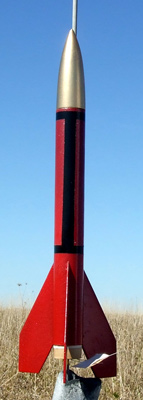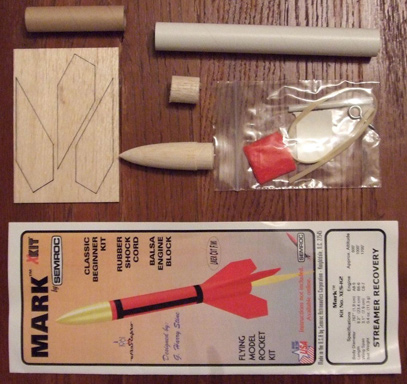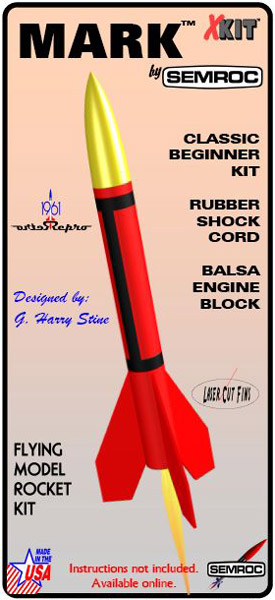| Construction Rating: | starstarstarstarstar_border |
| Flight Rating: | starstarstarstarstar_border |
| Overall Rating: | starstarstarstarstar_border |
| Manufacturer: | Semroc  |
 Brief:
Brief:
Not being much of a rocketry historian, I was a bit confused when I heard that Semroc was releasing the Mark. After
all, I already had stashed away a numbered Mark II kit, as well as a Mark II offered in 2007 at NARCON. Looking over
the JimZ archives, I could see
very little difference between the Estes Mark and the Estes Mark II.
After a bit of research, I learned that the Semroc Mark II is really a replica of the Carlisle Rock-a-Chute Mark II, which featured one of the ugliest nose cones I've ever seen (fashioned from a crayon sharpener). The Semroc Mark (plain) is modeled after the Estes K-2 design (which in turn was based upon the Carlisle Mark II). It was Estes' second design, which followed on the heels of the tumble recovery Scout, intended to demonstrated additional recovery methods. This small, lightweight rocket flies to eye-straining (or even vanishing) altitudes and uses streamer recovery.
Construction:
This is considered an xKit, meaning it's marketed as a bag of parts without instructions, though instructions are
available at the JimZ archive site. Semroc had previously had a couple befuddled customers of their bag-o-parts kits
who did not have the savvy to navigate online to find the archives, and as a precaution Semroc will only sell xKits
direct to online customers.
 Your $6.50 retail buys the following parts:
Your $6.50 retail buys the following parts:
- Balsa nose cone
- BT-30 body tube
- Balsa engine block
- Laser-cut balsa fins
- Crepe paper streamer
- Rubber shock cord
- 1/8" lug
Construction on this is pretty simple, as it's just a basic 3-fin/nose cone style rocket, and by upgrading to laser-cut fins, Semroc has eliminated the hand cutting from the original.
This is a minimum diameter model, so there is no motor tube assembly. Instead, you simply glue a thrust ring into the body tube. In sticking with the 1961 design, Semroc provides a balsa block that's been bored out (roughly 1/2" long) instead of the more modern (and cheaper) 20/5 centering ring approach. There's certainly nothing with this, but I was curious what that part was for, and needed to confirm its use by checking the instructions. Other than that one step, I did not actually need the instructions for this.
I did deviate from the plan slightly, by ditching the rubber shock cord and tri-fold mount in favor of Kevlar® line looped around that balsa block, attached to 15" of elastic as it clears the body tube. I know the rubber is sticking with the original design, but I've had less than stellar success with rubber and so think the upgrade is well worth the effort.
The fins were attached using a bead of medium CA followed up with white glue fillets.
Nose cone attachment is via screw eye in the shoulder. The crepe paper streamer is held on via an adhesive band cut onto label paper.
 Finishing:
Finishing:
The cover art from 1961 shows a pretty complex paint pattern, especially considering this doesn't come with any
decals--checkerboard black/white pattern on the fins, and vertical stripes. The Semroc cover art looked a little nicer
and easier, so I tried to follow their lead a bit. I started with a gray primer base, then followed by painting the
body tube and fins a dark red metallic. The nose cone was painted with a gold metallic left over from my Sky of Gold
spree.
The Semroc cover art also included a neat looking set of black trim stripes--one vertical stripe with horizontal bands at each end. Having just masked and painted a couple Saturn 1b's, I felt up to the challenge and so cut some rectangular bands of tape about 2-3/8" long, then drew a vertical line up the body tube (from forward fin joint) using a short piece of angle. That line would represent my centerline for the vertical black band. I then applied the 2-3/8" strips of tape about 3/8" short of each end of the line, with the gap (2-3/8" is too short to make it around the body tube) centered over the line. I then masked off horizontal bands for the other end of the 3/8" top/bottom bands, and shot the exposed areas with Rustoleum® gloss black.
The finished effect doesn't look quite as nice as the Semroc cover art, but I was fairly pleased. I'd like to have gone a lighter red, but the metallic is a nice effect.
Construction Rating: 4 out of 5
Flight:
Recommended motors are all long delay 18mm's of A8-5, B6-6, C6-7. I grabbed an A8-3 from an open Blast Off Flight
Pack I'd picked up for half price. It absolutely boogied off the pad and even on an A8 was a strain to track to apogee.
The delay was very clearly too early and even a -5 would be slightly before apogee. I suspect I could also track this
on a B, but unless you're feeling lucky avoid using C's unless using some tracking powder as truely out of sight
flights would be in order.
Recovery:
The tiny (8") crepe paper streamer is mainly decorative/complying with safety code and does not really affect
the descent rate. The model is small and light enough not to care. Despite upgrading to Kevlar®/elastc
shock cord, I still managed to suffer a smiley dent in the nose cone. Guess I should have gone with even more elastic.
Flight Rating: 4 out of 5
Summary:
While there's nothing all that striking about this design (other than the fact it's less ugly than the Mark II), it
is a nice simple construction, uses quality components and there's clearly a nostalgic retro aspect to it. It flies
great. The only cons I'd offer are related to the adherence to the original design--rubber shock cord/tri-fold mount
and a decal for stripe to match the cover art would be sweet (though certainly add a buck or two to the cost).
Overall Rating: 4 out of 5
Other Reviews
- Semroc Mark By John Thompson (October 16, 2008)
Brief: I received this kit from Semroc at NARAM 50. Semroc gave the Mark to anyone who purchased a kit from them. The Mark is a reproduction of the Estes kit #K-02 and is part of the Semroc XKits line. The XKits line of rockets are beautifully recreated reproductions of classic Estes, FSI, and Centuri rockets we remember as kids. The Mark is a simple, super light 3FNC rocket ...
 |
 |
Flights
Sponsored Ads
 |
 |











